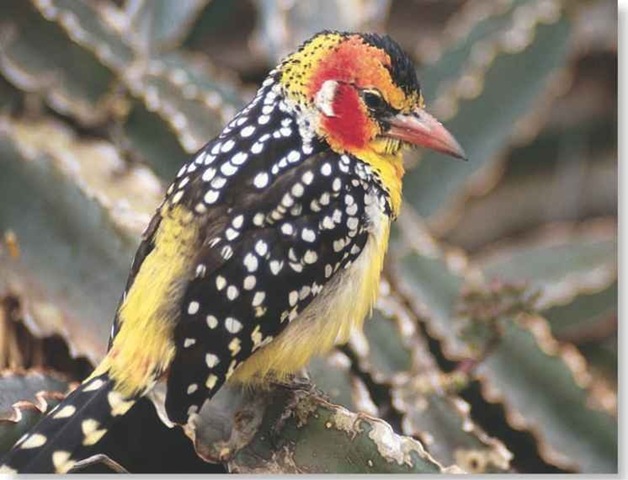ORDER
Piciformes
FAMILY
Capitonidae
GENUS & SPECIES
KEY FEATURES
• Alternating calls of pairs are so synchronized, sounds seem to be from one barbet
• Parents and immature helpers excavate the nest, share incubation and feed the nestlings
• Nests near termite mounds, but rarely eats the insects; in turn, termites don’t bite the barbet
WHERE IN THE WORLD!
Found in eastern and southeastern Africa, from Sudan, Ethiopia and Somalia, south to Uganda, Kenya and central Tanzania
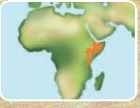
LIFECYCLE
Red-and-yellow barbets cooperate with family members to excavate and incubate a nest, forming a united front to staunchly defend their territory against uninvited company.
HABITAT
The red-and-yellow barbet prefers semiarid brush country and thornbush areas throughout its east African range. Anthills, termite mounds and stream beds from Ethiopia to Tanzania attract this African species; it is more likely to be seen on the ground than its forest barbet cousins, which rarely descend from treetops. The red-and-yellow barbet excavates its nest holes in mud or sandbanks, rotting trees or termite mounds. Nests near ant and termite colonies are protected by the biting insects, which do not attack the barbet. Reciprocally, the red-and-yellow barbet rarely eats its tiny neighbors.
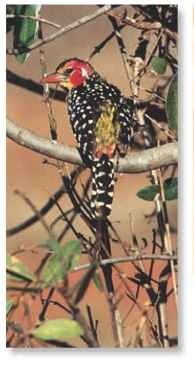
Sitting pretty The colorful barbet has a good view of its territory.
The species name erythrocephalus comes from the Greek words erythro and cephalos meaning “red head.”
A dueting pair occupies the topmost position in a tree or bush and forces away other singers that attempt to move upward or in between them.
BEHAVIOR
Remaining in family parties that do not migrate, the red-and-yellow barbet moves only in search of food. Boldly territorial, it may also be quite tame in areas where humans feed it. The alternating calls of the male and female produce a well-known duet, though the source of the sound often seems to be a single bird. The loud medley sounds much like the barbet’s English name, “red ‘n’ yellow,” over and over Used as territorial and breeding calls, the different song notes rhythmically synchronize, and the duet sometimes becomes a chorus of the combined efforts of the entire family party.
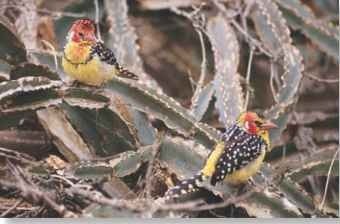
STICKING TOGETHER
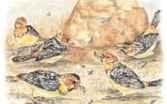
Feeding…
Nesting near a termite mound, a family party of barbets forages together for berries, locusts and beetles.

Squabbling…
Almost half as big and not as aggressive, a willow warbler is no match for the territorial red-and-yellow barbet.

Attracting…
Sensing the commotion, a snake, attracted to one of the other barbets, is preparing to strike, but…
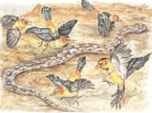
Mobbing
the barbet sounds an alarm call, rapidly bringing other birds together to mob the hastily retreating snake.
BREEDING
Nests are commonly made near large ant or termite mounds. While termites are aggressive territorial defenders against other potential predators, these insects do not attack the nesting birds; the reason is unknown. Both the mature adults and juvenile helpers, which have not yet reached sexual maturity, excavate the 16″ nesting tunnel.
During courtship the male chases the female, strutting and posturing around her with his bristled crown feathers raised. Both parents and helpers incubate 4-5 eggs and feed the nestlings insects.The barbet breaks up large insects into pieces against a rock or crevice in a tree, which may be used again and again.With wings and legs removed, the insects are carried directly to the young, rather than being regurgitated and fed to the them as is the case with many birds.
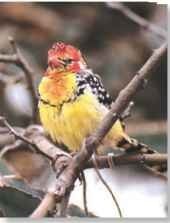
A Courtship crown
The male’s colorful crown feathers are raised during courtship postures.
FOOD & FEEDING
The omnivorous red-and-yellow barbet forages on open ground and in bushes in search of fruits, berries and buds. The most insectivorous of all barbets, it also hunts for locusts, beetles and small birds. It depends more on insects than other barbets because of its terrestrial, rather than tree-dwelling, adaptations. Insect wings
and legs are regurgitated as pellets, similarto those of owls; however, the skins and seeds of grapes, berries and other fruits are passed in the feces.
Searching for sweets The barbet looks for berries while foraging on the ground.

CONSERVATION
Fairly common and widespread, the red-and-yellow barbet is not endangered and is quite tame around humans that feed it. Some people take advantage of the barbet’s friendly nature, and capture or kill the bird when it ventures near.Tribes, such as the Masai, use the barbets’ feathers for ornamentation.
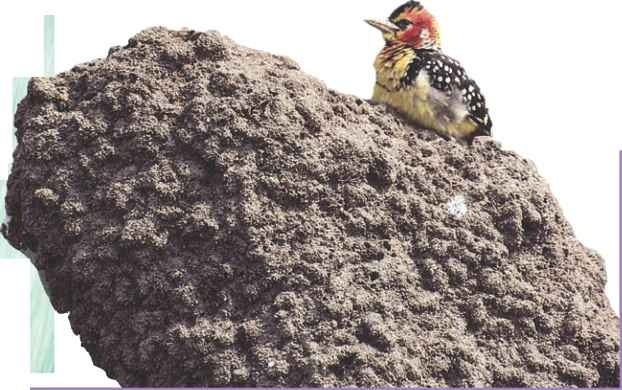
No bother
Termites don’t bite barbets, which often build their nests near termite mounds.
PROFILE
Red-and-yellow Barbet
Though it sings duets from the treetops, the red-and-yellow barbet is more likely to be seen feeding, nesting and quarreling on the ground.
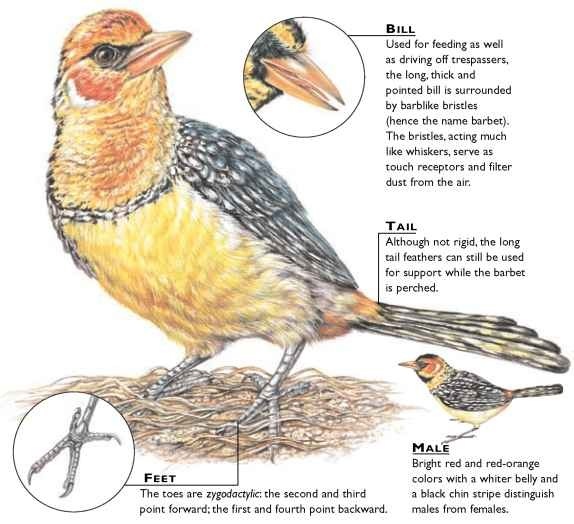
CREATURE COMPARISONS
A close relative, the pied barbet (Tricholaema leucomelaina) is distinguished by a black-and-white striped head, red forehead and black neck, though it appears mainly black and white. At 7″ it is smaller than the red-and-yellow barbet. At home in acacia woodlands from Zambezi south to the Cape Town area, it is occasionally found in pairs, but more often lives alone, searching for fruits, nectars and insects. Unlike its noisy cousin, the pied barbet rarely socializes. With no “helpers,” pied barbet parents excavate, incubate and feed their nestlings alone.
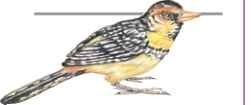
Red-and-yellow barbet

| VITAL | ||
| STATISTICS | ||
| . Weight | 2.5 oz. | |
| Length | 9″ | |
| Wingspan | 4″ | |
| Sexual | 1 year | |
| Maturity | ||
| Mating | Varies | |
| Season | depending on | |
| region | ||
| Number of | 2-6 | |
| Eggs | ||
| Incubation | 2 weeks | |
| Period | ||
| Fledging | 3-5 weeks | |
| Period | ||
| Breeding | 1 year | |
| Interval | ||
| Typical | Fruits, berries | |
| Diet | and insects | |
| such as locusts | ||
| and beetles | ||
| Lifespan | Unknown | |
RELATED SPECIES
The order Piciformes contains six families and includes jacamars, puffbirds and toucans, which are all found only in Latin America. The barbets, honeyguides and woodpeckers are also found in Africa. Almost half of the 81 species of barbet live in Africa. I The genus Trachyphonus [includes the red-and-I yellow barbet and D’Arnaud’s barbet, Trachyphonus darnaudii.
